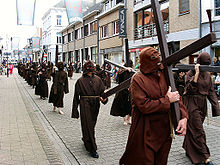Veurne
| Veurne | ||
|---|---|---|

|

|
|
|
|
||
| State : |
|
|
| Region : | Flanders | |
| Province : | West Flanders | |
| District : | Veurne | |
| Coordinates : | 51 ° 4 ′ N , 2 ° 40 ′ E | |
| Area : | 96.34 km² | |
| Residents: | 11,903 (Jan. 1, 2019) | |
| Population density: | 124 inhabitants per km² | |
| Post Code: | 8630 | |
| Prefix: | 058 | |
| Mayor: | Peter Roose (Veurne Plus) | |
Local government address : |
Stadsbestuur Veurne Sint-Denisplaats 16 8630 Veurne |
|
| Website: | www.veurne.be | |
Veurne ( French Furnes ) is the capital of the arrondissement of the same name in the Belgian province of West Flanders .
City structure and location
The municipality of Veurne consists of the districts and suburbs:
|
|
Veurne is on the Lichtervelde - Dunkirk railway and is linked by canals to Nieuwpoort , Dunkirk, Bergues and Ypres .
history
On August 13, 1297, the French under Count Robert II of Artois defeated the Germans and Flanders under Count Wilhelm von Jülich . Veurne was fortified earlier and was conquered for Spain by Alexander Farnese in 1583 . During the First World War, Veurne was in the small part of Belgium that was not occupied by German troops.
Town twinning
Veurne has had a town partnership with Rösrath in North Rhine-Westphalia since 1974 .
Attractions
- The marketplace
- The large rectangular market square is surrounded by an attractive ensemble of historic buildings. Including the town hall, the former court with tower and the old meat hall, all from the early 17th century. The belfry was added to the UNESCO World Heritage List in 1999 . The two churches of St. Walburga and St. Nicolas can also be admired from the market.
- St. Nicolas Church
- The St. Nicolas Church originally dates from the 12th century and was rebuilt between 1494 and 1497. It has a three-part altarpiece from the 16th century by Jan van Amstel .
- In the tower of the church there is a small chime - Museum .
- Spanish pavilion
- The Spanish Pavilion was built between 1448 and 1530 and was used as a town hall until 1586 .
- St. Walburga Church
- The previous building, which was dedicated to Our Lady and served as a castle chapel, was built in the 9th century. Around 870 relics of Saint Walburga and her brothers Wunibald and Willibald von Eichstätt were transferred to the church. In the 13th and 14th centuries, the construction of a larger St. Walburga church in the Gothic style began. Only the choir, two yokes of the nave and the base of the tower were built. The deep foundation of the tower was subsequently used as a water reservoir (Citerne) for service and extinguishing water. The neo-Gothic transept was not completed until 1907.
- St. Walburga Park
- Green area in the center of Veurnes. In the south is the castle hill of the medieval, count's castle. In the center there is a pavilion, a cast iron construction from 1899. There is a gilded lyre on the roof . To the east is the Sint-Walburgakerk, whose former churchyard forms part of the park. The park is bordered by the green garden walls of the surrounding properties.
Veurne arrondissement
Other structures
- NAVO-Toren is a 243 meter high directional radio mast near the municipality of Houtem, which belongs to Veurne.
Penitential procession
Every year on the last Sunday in July there is a penitential procession in Veurne, during which the penitents, wrapped in robes that hide their faces, drag heavy crosses and large figures. This tradition originated in the 17th century when Veurne was occupied by the Spanish.
When "t 'Bomtje", the bell of St. Nicholas' Church strikes at 3:30 p.m. sharp for the penitential procession, the shops of the fair on the Grote Markt are closed. Fanfares sound. In front of each group, a sign announces the biblical scenes that are recreated in contemporary costumes. An angel quotes the relevant Bible passages, such as B. Fall , Stable of Bethlehem or Pilate . Around 200 hooded penitents, some of whom are barefoot, carry crosses weighing up to 25 kilograms. Rainer Maria Rilke wrote in 1906: “At first, of course, one thinks that these penitents in particular lack seriousness and attitude. But the more often you see them again, the more sincerely and thoughtlessly their carrying becomes, the more the cross comes over them under the full sun, with all of its obscurity. "
Personalities
- Auguste Declercq (1870–1939), religious and apostolic vicar of Ober-Kasaï; born in Avekapelle
- Paul Delvaux (1897–1994), painter of surrealism , last lived in Veurne and died there.
- Sander Loones (* 1979), politician; born in Veurne
- Tom Devriendt (* 1991), racing cyclist; born in Veurne
- Ivan Khodulow (* 1994), Bulgarian ice hockey player; born in Veurne
Web links
- Official City Page - ( Dutch )
- Information on the penitential procession - ( Dutch )
- Veurne - pictures and maps
Individual evidence
- ^ Parochiekerk Sint-Walburga. Retrieved June 20, 2017 (Dutch).
- ↑ Sint-Walburgapark. Retrieved June 20, 2017 (Dutch).







